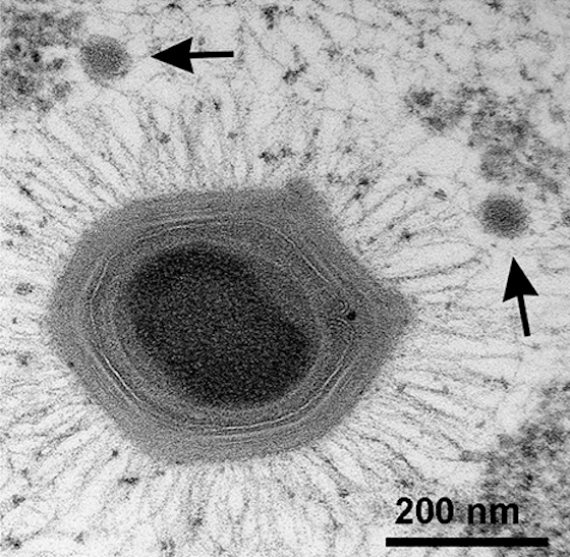We live on a planet of viruses. This statement may have seemed too provocative when in 2011 journalist Carl Zimmer used it as a starting point for his book A Planet of Viruses. Now, in 2020, it may seem premonitory, after the new coronavirus SARS-CoV-2 has managed to infect humans and spread rapidly around the world, causing a pandemic that has changed all our lives. But regardless of whether this statement sounds provocative or prescient, it is increasingly scientifically based.
A recent study estimates the number of individual viruses on Earth at 10 quintillion (a one followed by 31 zeros: 1031). That makes them not only the most abundant type of organism on our planet, but there are many more viruses on our world than there are stars in the whole universe. Another recent study places this overpopulation on a more human scale: every day an average of 800 million viruses fall (attached to dust particles) on every square metre of the Earth’s surface. They truly are everywhere, in every land or marine ecosystem, and even many metres underground, in strange caves full of gigantic crystals. Everything is impregnated with these tiny organisms whose existence we were unaware of until 121 years ago because they cannot be seen with optical microscopes. “For thousands of years, we knew viruses only from their effects in sickness and death. Until recently [at the end of the 19th century], we did not know how to join those effects to their cause,” Zimmer says in his successful book, a work for readers interested in learning about the science of virology.
“Viruses are unseen but dynamic players in the ecology of Earth. They move DNA between species, provide new genetic material for evolution, and regulate vast populations of organisms,” explains Judy Diamond, director of the World of Viruses project. “When you consider how every animal, plant, and microbe has been shaped through the course of evolution, one has to consider the influential role played by the tiny and powerful viruses.” According to this researcher, virology can help us not only to fight this and future pandemics, but also to understand our evolution.
Interactive timeline: the Discovery of Viruses
[+] Watch Fullscreen
Meanwhile, the very evolution of viruses is an enigma. Their definition leads us to a classic chicken-or-egg dilemma. Viruses are extreme intracellular parasites; in other words, they are only able to reproduce if they enter a cell of a living being and take control of its biological mechanisms, turning it into a factory to produce virions—the individual viral particles, which basically consist of a handful of genes (in the form of DNA or RNA), surrounded by a protective capsule of proteins. The discovery of this composition and form of reproduction of viruses has led us to see them as “cellular gene robbers’’ understanding their origin as by-products of the genomes of the cells of the bacteria, fungi, plants, animals and other living organisms that they infect. Their evolution would then be explained by the fact that in this process of multiplication, viruses recruit genes from the infected cell.
Three big ideas to solve the puzzle
This traditional view of the evolution of viruses has recently been faced with a powerful contradiction. Most of the proteins of the viruses that we are familiar with do not have their equivalent in the cells of the living organisms we know about, suggesting that they could have originated in very primitive cells before LUCA (the “last universal common ancestor”, from which all living beings today are descended). The origin of viruses is very difficult to nail down because, among other reasons, they do not form fossils. So all we can do is to apply molecular biology techniques to study their genes. These studies have led to three main explanations:
- the reduction hypothesis: viruses were originally a type of small cell that parasitized larger cells. Over time, they lost genes, keeping the ones that were essential for parasitism. Something similar happens with some bacteria—from the genera Rickettsia and Chlamydia—which can only reproduce inside host cells.
- the escape hypothesis: viruses could have originated from fragments of genetic material in cells, which escaped from them. The discovery of transposons (also known as “jumping genes”) by Barbara McClintock in 1950 helps us to understand the biomolecular mechanisms by which this might occur.
- the co-evolution hypothesis: viruses could have their origin in complex biomolecules (proteins and nucleic acids), at the same time as the most primitive cells appeared, and have been dependent on them ever since. Viruses and cells would have evolved together from the beginning.
So far, it has not been possible to prove that one of these three hypotheses is correct, and all of them contradict in one way or another the definition or composition of viruses. The comparative study of virus and cell genomes has not yet managed to clarify the origin of viruses, but consensus has begun to emerge around the idea that viruses are ancestral and predate the division of life into three domains. It also seems clear that—unlike cellular life, which comes entirely from LUCA—current viruses do not have one single common ancestor, but appeared several times during evolution by one or more of the mechanisms set out in these three hypotheses.

Be that as it may, these discoveries lead us to think of viruses as more than just a tiny, invisible threat to our health and lifestyle; much more than that, they are essential to life on Earth and to its evolution. They are a rich source of genetic diversity. Viruses evolve much faster than any other organism, and so by infecting the living things they parasitize they also gain access to new genetic material that can help them adapt and survive. Evolutionary biologists are beginning to accept that advances in the science of virology should therefore bring us new clues to the origin of life and to evolution.
Comments on this publication